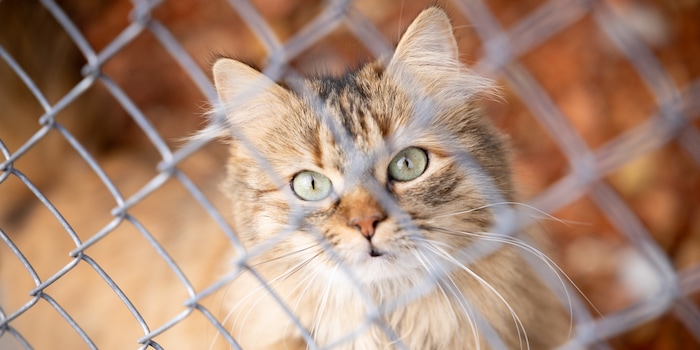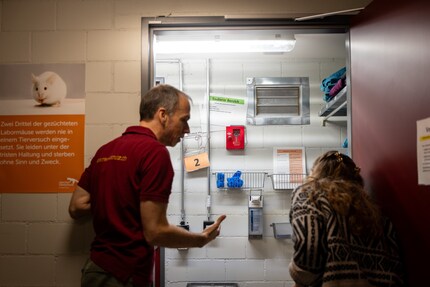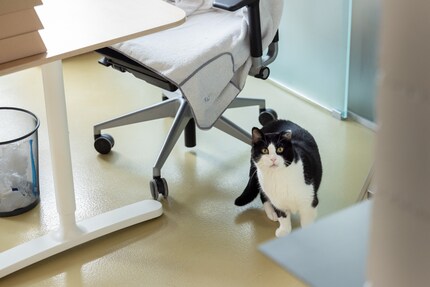
Background information
Cats get to sip Pawsecco at this hotel
by Darina Schweizer

Since getting two rescue cats myself, all the misconceptions about animal shelters annoy me more than ever. To bust some myths, I took a trip to the Zurich Animal Protection’s animal shelter and spoke about the five most common clichés with the manager.
«What a miserable day,» I think to myself, looking up at the grey sky as I get off the tram at the zoo. Just 800 metres up the road from there is where Zurich’s animal protection association «Zürcher Tierschutz» runs its shelter](https://www.zuerchertierschutz.ch/en/tierheim/zuhause-gesucht). If I’m to believe all the common preconceptions about shelters, things are about to get even more miserable.
Not the case here. In front of me, there’s a modern building with huge windows. As I enter, I hear birds chirping in the background. It’s peaceful and feels more like a refuge than a shelter. «It’s so nice here!» I say to the animal keeper at the reception, who takes me to see the manager.

Rommy Los greets me with a smile – and a Chihuahua lady at his feet. «Lou’s also from the shelter, that’s why she has a chip on her shoulder,» he quips. «Sure she does,» I reply with a laugh and follow Rommy, who tells Lou to stay with a short sign. The dog isn’t allowed where we’re going.
After walking down a long corridor, we stop in front of a room labelled «Quarantine». This is where all animals come after their entry check. It’s where they’re examined for diseases, vaccinated and chipped. But where do the cats, dogs, rodents, birds, snails, amphibians and reptiles that end up at the shelter come from?

Rommy explains that around 80 per cent of the animals at the shelter were no longer wanted. «The owners hand them in because they’ve moved house, have taken on a new job, have a child who’s developed an allergy or have underestimated the care, time or costs of keeping an animal.» There’s also a small number of strays and a few animals that were confiscated due to neglect or other issues. It’s a common misconception that only really difficult animals end up in shelters, but Rommy strongly disagrees.
«If you randomly knocked on the door of a house with pets, you’d come across roughly the same kind of animals as we have here. We’re a mirror of society.»
We enter the cat area, our original destination. Last year, a total of 190 cats were taken in at the animal shelter. «Which of them are still here?» I want to know. «Only very few,» says Rommy. On average, it’s one in, one out every day. Around 90 per cent of the cats find homes within the first three months. For difficult animals, it’s about six months. Very challenging dogs sometimes don’t find homes for over a year.
We head for the next stop: the 14 cat rooms. This is where the healthy animals are distributed to after going through quarantine. Cats with similar personalities are grouped together. And frightened felines? Rommy points through the window of a staff office. We can see a black and white cat slink past. This is where anxious cats can slowly get used to people. «I don’t think we’ve ever failed to find a home for a cat,» Rommy says.

After a few weeks, the employees usually have a pretty good idea of what a cat’s like and have had time to document all their traits and peculiarities. That’s when it’s time to post an ad online. «Isn’t it absurd that people often say you don’t know what you’re going to get at a shelter?» I ask. Rommy nods.
«It’s not like you know what you’re getting with a thoroughbred or a kitten from a farm. It might turn out months later that the animal refuses to get into a car, that you can’t leave it home alone or that it has a disease. And that’s when the animals end up here.»
We walk past a door marked «Feeding kitchen», where food and medicine are prepared. The animal shelter, which is funded by private donations, spends the most money on medical care and labour costs – around 100,000 francs a year, roughly five times more than on food. It’s a strong reminder why some pet owners can’t afford to keep a sick animal. «It’s sad, but I don’t blame them,» says Rommy. «I’d prefer people bring in their cats than abandon them.»
It’s time to meet some shelter cats. Harper and Lemon live in room number 6. They throw me a content glance from their raised beds. «Are they allowed out?» I want to know. Rommy points upwards. There’s a cat staircase leading up to an opening in the ceiling. «That’s the way to the roof.» That’s where we’re heading for, but via the human staircase, of course.



On the roof, there are several spacious enclosures with climbing facilities. There’s one question I’ve been dying to ask because I was recently looking for a cat to adopt: «You rarely find indoor cats in animal shelters, right?» Rommy shrugs:
«We only have a handful of cats that lived strictly indoors. However, if they show interest in the outdoor enclosure, we’ll advertise them as outdoor cats. We also allow young cats out. We’d like to at least give them the choice.»

I should also be heading out, I’ve long overstayed visiting hours. It’s hard to leave with all those longing looks of the cats. I take comfort in the fact that even the shyest ones will find a home soon. «There’s always great interest in shelter cats,» Rommy says on the way out. «Only recently, a young couple adopted an old cat to give it a nice retirement. I’m still touched by that.»
So am I. When I step out of the building, the sky’s no longer grey. Maybe it’s the sun, but maybe also the realisation that the problem isn’t the shelter animals, but the misconception people have who never took the time to get to know one.
I love anything with four legs or roots - especially my shelter cats Jasper and Joy and my collection of succulents. My favourite things to do are stalking around with police dogs and cat coiffeurs on reportages or letting sensitive stories flourish in garden brockis and Japanese gardens.
Interesting facts about products, behind-the-scenes looks at manufacturers and deep-dives on interesting people.
Show all